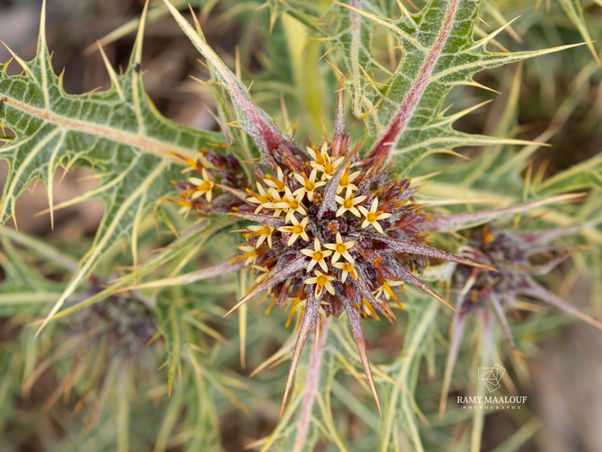Family |
Asteraceae
Gundelia tournefortii
L.
East Mediterranean
Gundelia tournefortii L.
(Sp. Pl.: 814; 1753 – Nouvelle Flore du Liban et de la Syrie, vol. 2, Pl. CCXXXVII nº 3; 1969)
• Life-form & habit: Robust perennial thistle-like herb, 30–80 cm tall, with a thick taproot and a stout, spiny, branching stem. Whole plant covered with short, rigid hairs and often tinged with purple. When mature, the entire plant becomes detached and rolls with the wind, acting as a tumbleweed.
• Leaves: Alternate, sessile, deeply pinnatisect, segments spiny, rigid, and glabrous above, grey-green beneath; basal leaves 15–25 cm long, forming a rosette; upper cauline leaves smaller, clasping the stem with spiny wings.
• Inflorescence & flowers: Dense, globular to ovoid capitula (2–3 cm in diameter), clustered in large terminal heads. Each small head composed of 1–3 fertile flowers surrounded by numerous spiny bracts. Flowers tubular, purple to purplish-pink; anthers fused into a tube; style exserted. Involucral bracts hard and sharp, giving the inflorescence a globose, armored aspect.
• Fruit: Achene enclosed within a spiny involucre that persists as a hard, dispersal unit; fruiting heads separate as spherical segments aiding in wind dispersal.
• Phenology: Flowers from March to May; fruiting from May to July.
• Habitat & elevation: Dry rocky slopes, open steppe, and semi-desert grasslands, often on limestone or marl, 400–1 600 m. Thrives in arid, sun-exposed environments and disturbed soils.
• Lebanese distribution: Widespread in the Beqaa Valley and foothills of Mount Lebanon, from Ain Dara to Ras Baalbeck and Baalbek; locally abundant in dry steppe vegetation, field margins, and fallow hillsides.
• Native to: Cyprus, Lebanon-Syria, Palestine, Sinai, Türkiye (POWO).
• Introduced into: Algeria (POWO).
• ⚠️ Taxonomic note: Gundelia tournefortii is a distinctive monotypic genus of the Eastern Mediterranean steppe flora, characterised by its spiny, compound inflorescences and tumbleweed dispersal strategy. Mouterde described it as a typical plant of arid Levantine plains and submontane steppes, forming dense colonies on disturbed limestone soils. Locally known in Lebanon as “ʿAkkoub,” the species is edible when young and widely gathered in spring for its tender shoots, though overharvesting has led to regional population declines.








